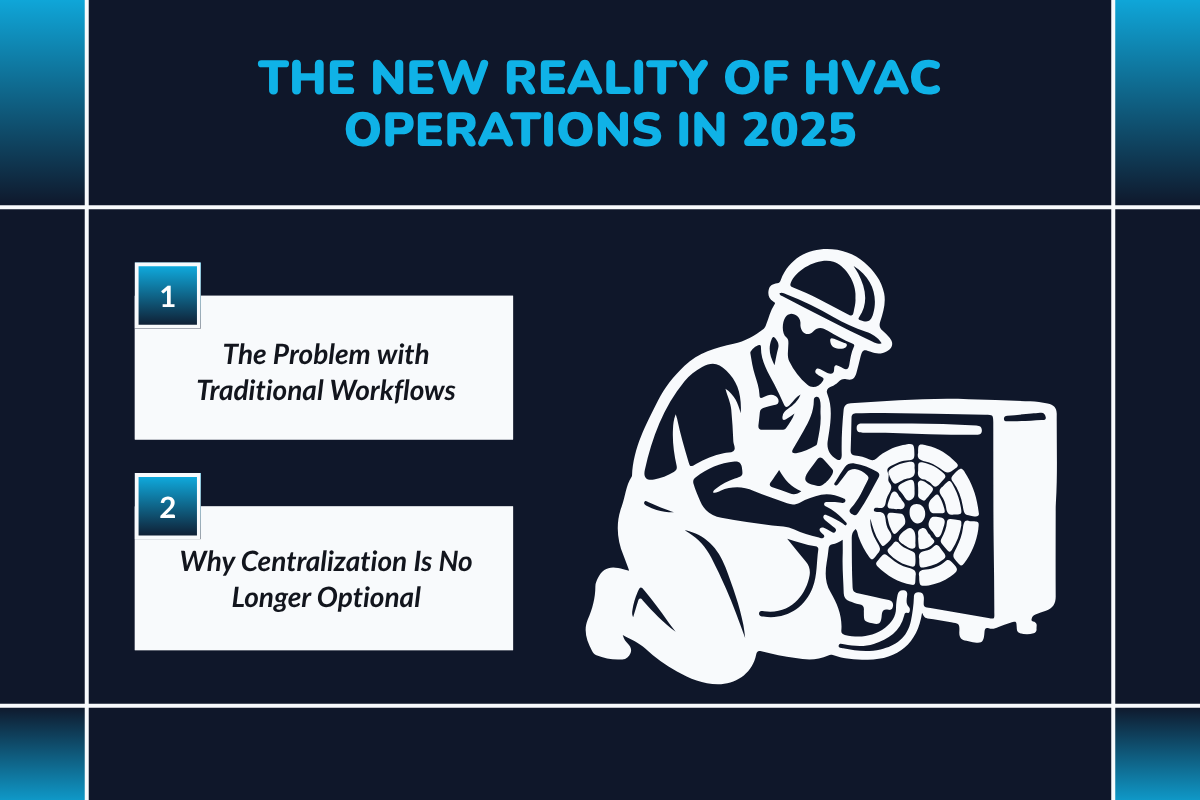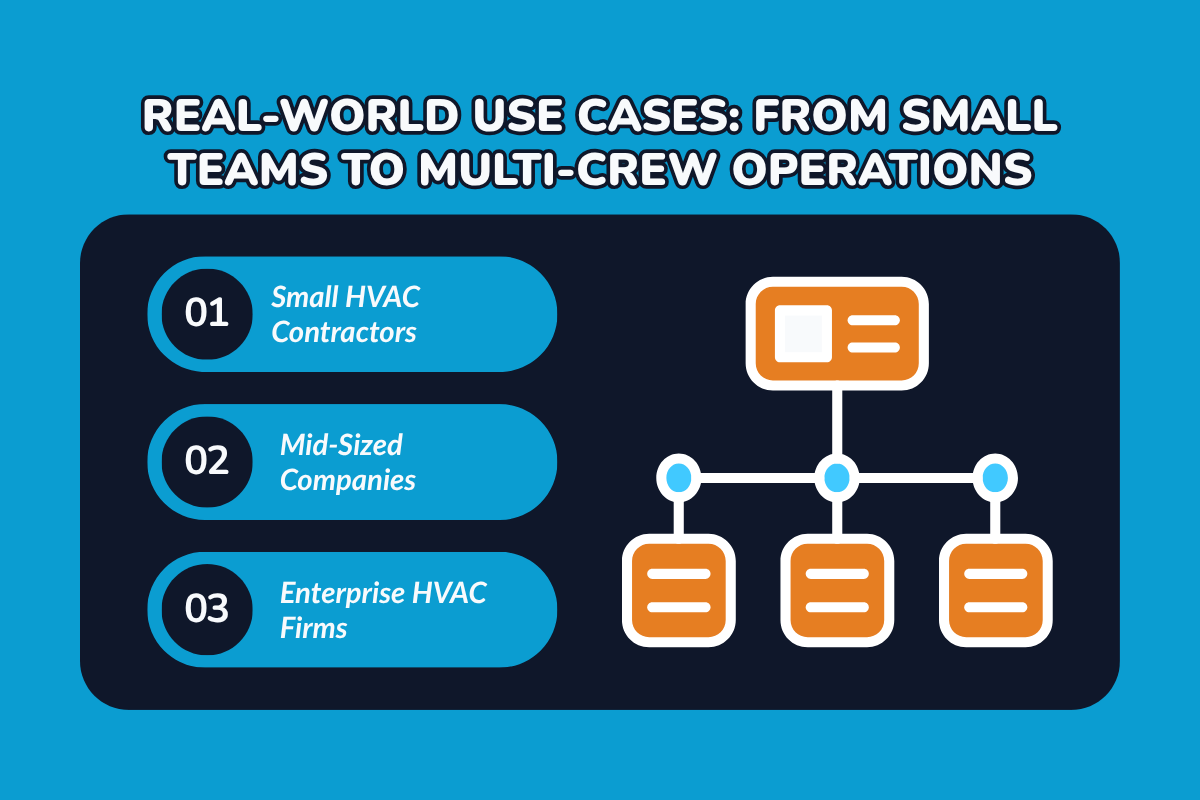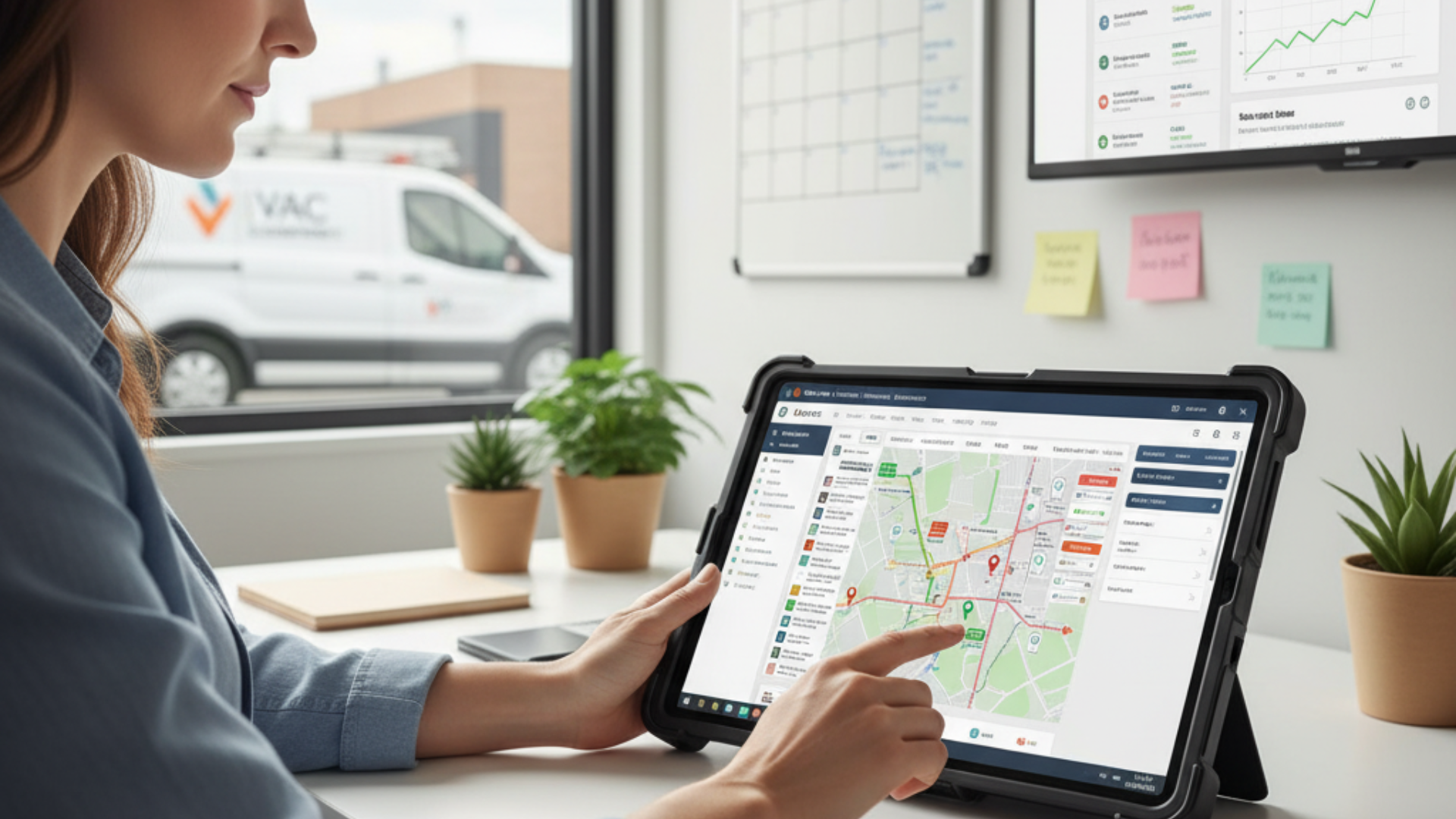HVAC Management Software: What Every Contractor Should Know
The HVAC industry is evolving rapidly, and the days of managing jobs with spreadsheets and phone calls are behind us. Modern contractors are increasingly turning to HVAC management software to streamline operations, minimize administrative tasks, and boost profits.
It brings scheduling, invoicing, and customer management into one place, so nothing slips through the cracks.
And the best part? It doesn’t matter if you’re a solo contractor managing a handful of clients or leading multiple teams across different sites- the right software grows with you.
HVAC Management Software: Essential Tools Every Contractor Needs
Running an HVAC business today isn’t what it used to be. Between juggling service calls, handling invoices, and keeping customers satisfied, many contractors find themselves overwhelmed by a pile of paperwork and disconnected tools. What once worked with pen, paper, and a few spreadsheets now slows you down.
Modern HVAC businesses need speed, coordination, and visibility. That’s where HVAC management software steps in.
Take it as the digital backbone of your operations, keeping your technicians, office staff, and customers connected from the first quote to the final payment.
In this article, we’ll break down what HVAC management software really does, why it’s become essential in 2026, and how it helps contractors save time, increase profits, and streamline operations.
Key Takeaways
- HVAC management software unifies scheduling, dispatching, invoicing, and reporting in a single platform.
- It eliminates manual data entry, miscommunication, and paperwork.
- Top platforms integrate CRM, accounting, and field service tools for smoother collaboration.
- With real-time visibility, business owners can make smarter, faster decisions.
Tired of juggling schedules, invoices, and customer calls manually?
Simplify your workflow with HVACBase, the all-in-one platform designed for contractors who want to work smarter, not harder. See how HVACBase helps you schedule, dispatch, and get paid, all from one dashboard.
The New Reality of HVAC Operations in 2025

The HVAC industry is evolving faster than ever, and outdated workflows can’t keep pace. Here’s how shifting to centralized, software-driven operations is redefining how contractors manage speed, service, and profitability in 2026.
The Problem with Traditional Workflows
Walk into any HVAC office still relying on whiteboards and spreadsheets, and you’ll see the same challenges repeating:
- Missed calls and unclear job details.
- Double-booked technicians and disorganized schedules.
- Estimates lost in endless email threads.
- Paper invoices are piling up, resulting in payment delays.
- Office staff are scrambling to locate job statuses for customers.
It’s not that teams aren’t trying; it’s that the tools can’t keep up. In a world where customers expect instant answers, those delays can cost you both revenue and reputation.
Why Centralization Is No Longer Optional
Speed defines today’s HVAC market. Customers want:
- Same-day service.
- Digital quotes.
- Real-time updates.
That’s impossible when your data lives in ten different places.
Centralized HVAC business management software brings it all together. It can:
- Track technician routes and job statuses.
- Create and manage invoices instantly.
- Access performance and system reports in real time.
Everything is managed within a single dashboard, providing you with complete operational control and helping your business stay competitive in a fast-paced market.
What Is HVAC Management Software? And What It’s Not.
Many HVAC businesses outgrow spreadsheets and basic scheduling tools without realizing it. Here’s what genuine HVAC management software actually does and what it isn’t so that you can understand its real value to your operations.
HVAC management software is a unified platform that manages your entire service lifecycle from lead capture and job scheduling to invoicing and customer follow-ups.
It’s built specifically for HVAC contractors, combining the power of CRM, project management, and field service management software into a single tool.
It connects the office to the field, ensuring technicians, dispatchers, and managers always see the same information.
What It’s Not
It’s not just a fancy calendar app or a billing system. While it does handle scheduling and invoicing, the best HVAC software solutions go far beyond these basic functions.
They automate workflows, track technician performance, manage customer data, and help you forecast business growth.
And it’s definitely not a one-size-fits-all tool. Every HVAC business, whether residential, commercial, or industrial, has unique challenges. The right software adapts to your workflow, not the other way around.
To help you with Scheduling: Smart HVAC Scheduling: Using AI to Predict Service Needs
The Core Building Blocks of HVAC Management Software

Managing an HVAC business requires more than skilled technicians; it also necessitates smart tools that connect your operations, automate daily tasks, and keep your entire team in sync, from the office to the field.
1. Smart Scheduling and Dispatching
If you’ve ever spent hours juggling technician routes, you’ll appreciate this feature immediately. Smart scheduling tools use drag-and-drop calendars to assign jobs based on technician availability, location, and skill set.
Add GPS tracking and route optimization, and you’ve just cut hours of wasted drive time.
Take a scenario, your dispatcher dragging a service call to a tech’s route, and within seconds, the tech gets a mobile app notification with the job details, customer address, and optimized route. It’s fast, accurate, and eliminates guesswork. This isn’t just about saving time; it’s about reducing stress and improving your team’s efficiency every single day.
2. Estimate to Invoice Automation
Manual data entry between quotes, work orders, and invoices often results in errors. However, with HVAC invoicing software, everything connects automatically:
- Send digital estimates
- Convert them into invoices once approved
- Collect online payments all within one system
This automation streamlines cash flow and reduces administrative burdens. Integrations with QuickBooks or other accounting software ensure that your financial records stay in sync, eliminating the need for endless copy-pasting and duplicate data.
The result: Faster payments and fewer billing disputes.
3. Field Team Collaboration
For HVAC technicians, time in the field is everything. The best HVAC management systems come with a mobile app that provides technicians with real-time job details, customer notes, and even a history of past services.
They can upload before-and-after photos, update job progress, and mark tasks as complete directly from their smartphones.
Meanwhile, office staff get instant updates. If a job runs late or a part is missing, everyone is immediately aware. This transparency reduces customer calls, avoids miscommunication, and helps teams stay aligned throughout the day.
4. Inventory and Equipment Tracking
Few things are more frustrating than arriving at a job site only to realize you’re missing a part. HVAC business software includes tools for:
- Tracking stock levels
- Managing purchase orders
- Monitoring part usage per job
Barcode scanning makes it easy to check items in and out, while real-time tracking ensures you never run out of critical components. Some systems even link inventory to service history, so you can see which equipment was installed, serviced, or replaced.
5. Reporting and Performance Insights
Numbers tell the real story of your business. Built-in dashboards show revenue trends, technician productivity, and service performance.
You can track KPIs like first-time fix rate, average ticket size, and customer satisfaction, giving you a clear picture of what’s working and what needs attention.
For example, if one technician consistently takes longer on similar jobs, you can spot the issue early and offer additional training.
Or, if one service area brings in more revenue, you can double down on marketing there. It’s data-driven decision-making without the complexity.
To understand how HVAC Software helps you exactly, have a look at this: HVAC CRM Benefits: From Lead Capture to Repeat Business.
The Business Value: Why Contractors Are Making the Switch

Switching to HVAC management software isn’t just about convenience; it’s about transforming how your business operates. Here’s how modern contractors are cutting costs, boosting profits, and scaling faster with more innovative tools.
1. Reduced Administrative Overload
HVAC owners didn’t start their businesses to get bogged down in administrative work. Between scheduling, follow-ups, and billing, office staff can lose up to 10 hours a week to repetitive tasks. That’s time that could be spent on sales or customer care.
With HVAC field service software, repetitive tasks like data entry, follow-ups, and invoice generation are automated. The software handles the heavy lifting so your team can focus on what really matters: running jobs and keeping customers happy.
2. Higher Profit Margins Through Visibility
Every wasted trip, missed invoice, or untracked hour affects your bottom line. Real-time visibility gives you control over every moving part of your operation.
HVAC dispatch software helps you allocate technicians efficiently, reducing idle time. Financial dashboards let you see revenue by service type, so you know which jobs are most profitable. This level of insight helps you maximize profits without increasing your workload.
3. Consistent Customer Experience
Customer satisfaction isn’t just about fixing HVAC systems; it’s about communication. Automated notifications keep customers informed when a technician is en route. Post-service follow-ups ensure nothing slips through the cracks.
When a customer calls, your office staff can instantly pull up job history, technician notes, and service agreements. That speed and accuracy build trust, and trust leads to repeat business.
4. Easier Scaling for Growing HVAC Teams
Growth often exposes the cracks in a business. Adding technicians, vehicles, or service areas can turn chaos into the daily norm unless your systems are ready.
HVAC management software scales effortlessly. Whether you add new routes or hire more techs, the system maintains consistency across scheduling, communication, and reporting. New employees can get up to speed faster because workflows are already standardized.
That’s how small HVAC contractors grow into reliable, mid-sized businesses without losing efficiency or quality.
Criteria to Look For When Choosing the Right HVAC Management Software
When evaluating HVAC software, prioritize practicality over flashy features. Here’s what to look for:
| Evaluation Factor | Why It Matters | Example Application |
|---|---|---|
| Ease of Use | Simple software ensures adoption across your team. | Field techs can update jobs in two taps. |
| Mobile Capabilities | Real-time updates keep everyone in sync. | Technicians capture photos and collect signatures on mobile devices. |
| Integrations | Connects your existing tools for seamless access. | Sync CRM, accounting, and dispatch data automatically. |
| Customization | Adapts to your unique business model. | Add custom job types, rates, and workflows. |
| Support & Training | Ensures smooth onboarding and ROI. | Access live chat, webinars, or a dedicated support team. |
Choosing software that’s too complex can backfire. The goal isn’t to have “all the tools,” but the right tools your team will actually use.
Real-World Use Cases: From Small Teams to Multi-Crew Operations

Every HVAC business operates differently, but the right software adapts to all. Here’s how HVAC management tools deliver real results for small teams, growing companies, and large-scale enterprises alike.
1. Small HVAC Contractors
For small businesses, simplicity is key. You need a solution that handles scheduling, invoicing, and customer management without feeling overwhelming. With the right HVAC business software, even a single person can run an efficient operation that appears larger and more professional.
These contractors often see faster payments, reduced admin stress, and happier customers simply because everything runs smoothly.
2. Mid-Sized Companies
As you grow, coordination becomes your biggest challenge. You’re managing multiple crews, expanding service areas, and dealing with increasing job volumes.
Advanced HVAC field service management software provides performance tracking, route optimization, and financial visibility, enabling your team to strike a balance between speed and quality. The focus here is on scalability, doing more without sacrificing reliability.
3. Enterprise HVAC Firms
Large commercial HVAC service companies have complex needs like: multi-location coordination, compliance tracking, and data-driven forecasting.
They rely on fully customizable solutions with role-based permissions, advanced analytics, and automated service agreements. This provides management with a comprehensive view of all operations, ensuring consistency across crews, branches, and clients.
The Future of HVAC Management Software

The next wave of HVAC software is built around smarter automation and deeper connectivity.
- AI-Powered Scheduling: Predictive dispatching assigns jobs based on technician skill, location, and historical performance, optimizing productivity in real-time.
- Voice Commands: Technicians will update job statuses hands-free using voice, speeding up data entry in the field.
- Predictive Maintenance Alerts: With IoT sensors embedded in HVAC systems, software will alert you to maintenance needs before breakdowns occur.
- Eco-Efficiency Tracking: New tools will monitor the carbon footprint of your operations, helping your business track and promote eco-friendly service performance.
These innovations are trends that are shaping the future of every HVAC service business that wants to stay relevant and profitable.
HVACBase - The Operations Engine for Modern Contractors
Meet HVACBase, the all-in-one operations engine designed to streamline every part of your HVAC business, from scheduling to billing to team performance.
Why Backend Efficiency Drives Frontline Success
A successful HVAC company isn’t built solely on marketing. It’s built on operations that run like clockwork. If your technicians, office staff, and accountants aren’t connected, customer satisfaction suffers and so does your bottom line.
That’s where HVACBase comes in. It bridges every gap between office, field, and finance, helping contractors operate smarter, faster, and with less effort.
Key HVACBase features
- Smart scheduling and optimized technician routing: Innovative scheduling tools automatically assign jobs based on technician availability, skillset, and proximity. The system optimizes routes in real-time, meaning fewer miles are driven, less fuel is wasted, and more jobs are completed per day.
- Real-time technician tracking and dispatch management: With live tracking, you can see exactly which job each tech is working on, how long it’s taking, and where they’re headed next.
- Automated invoicing and integrated payment processing: Once a job is marked complete, an invoice is automatically generated and sent to the customer, complete with digital payment options like cards, wallets, or bank transfers.
- Inventory and parts management: This feature connects your field teams with the warehouse, ensuring that technicians have the right tools and materials when needed, reducing downtime and unnecessary trips.
- Custom dashboards with profitability and performance alerts: Knowledge is power — especially when it’s visual and in real-time. Custom dashboards give you a clear overview of your business: daily jobs completed, top-performing techs, profit margins, and outstanding payments.
- Digital job reports and compliance tracking: Technicians can complete digital job reports on-site, including photos, customer signatures, and service details, all synced automatically to the cloud.
- Role-based user permissions for teams of all sizes: Admins can manage financials, dispatchers handle scheduling, and technicians view only their assigned tasks.
With HVACBase, everything your business needs to run efficiently lives in one place, giving you control, visibility, and confidence as you grow.
Bringing It All Together
At the end of the day, HVAC management software isn’t just another tool; it’s a business transformation engine. It simplifies daily operations, boosts technician productivity, and creates a more seamless experience for both customers and staff.
As more HVAC companies transition to digital platforms, those still relying on spreadsheets will find it increasingly difficult to keep up. Whether you’re a one-truck startup or a multi-crew enterprise, now’s the time to invest in a platform that grows with you.
Tools like HVACBase give you everything you need to manage jobs, teams, and customers from one place, helping you turn everyday challenges into scalable success.
Ready to Streamline Your HVAC Operations with HVACBase?
If you’re ready to streamline operations, boost profitability, and deliver better customer experiences, it’s time to make the switch.
Book your HVACBase demo today and experience what connected, modern HVAC management looks like.
FAQs
What is HVAC management software, and how does it help contractors?
HVAC management software is a digital platform that streamlines scheduling, invoicing, dispatching, and customer management. It helps contractors save time, reduce admin work, and improve overall service efficiency.
How can HVAC software improve technician productivity?
With features like intelligent scheduling, GPS tracking, and mobile access, HVAC software enables technicians to spend less time on travel and paperwork and more time completing profitable jobs efficiently.
Is HVAC management software worth it for small HVAC companies?
Yes. Even small HVAC businesses benefit from software automation. It reduces manual work, improves customer communication, and helps you look more professional, leading to faster growth and higher profits.
Have questions or need personalized advice?
Talk to an Expert Today and let our construction specialists guide you to success.






